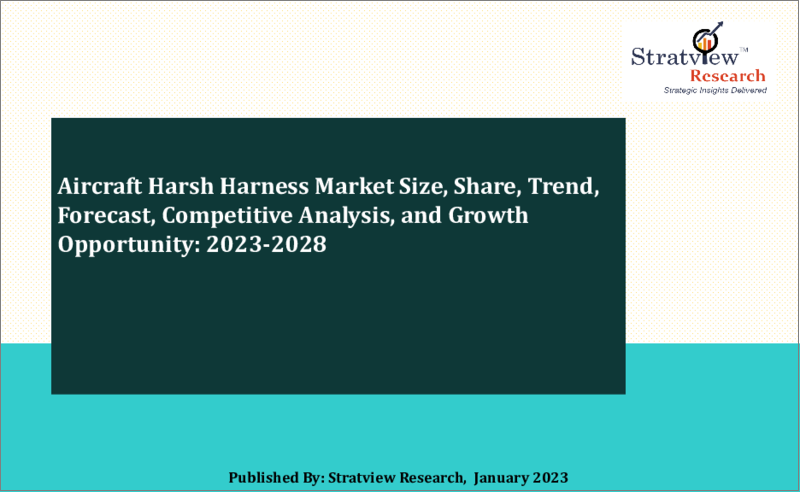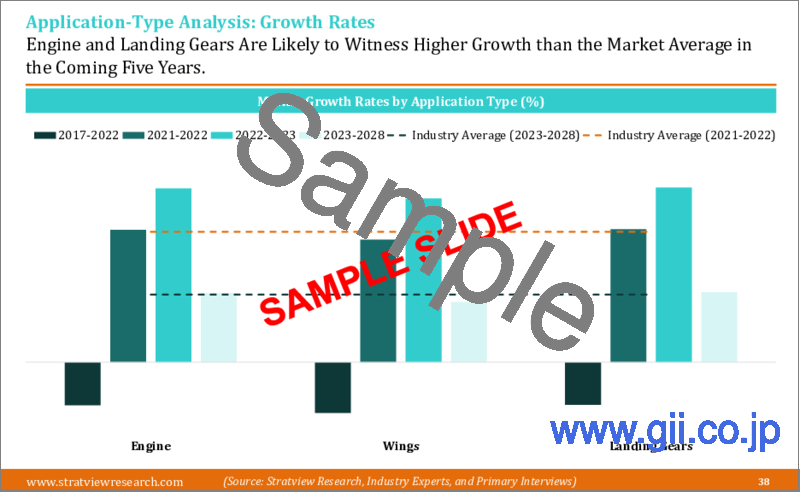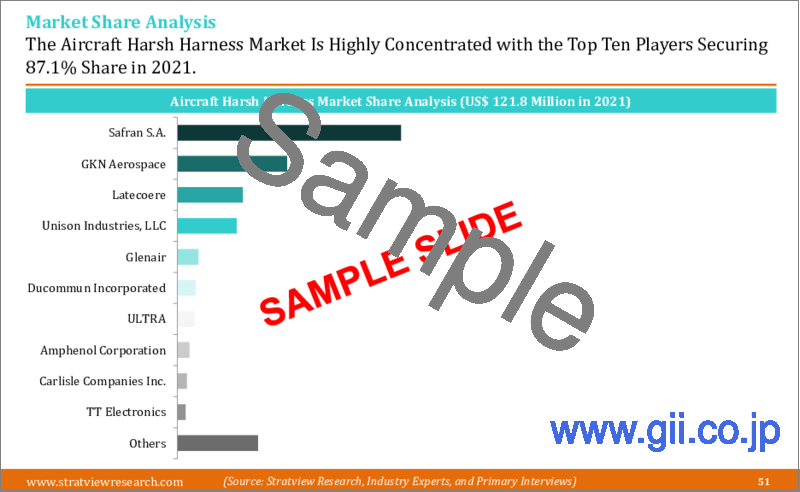|
|
市場調査レポート
商品コード
1224464
航空機用ハーシュハーネスの世界市場 (2023-2028年):市場規模・シェア・動向・予測・競合分析・成長機会Aircraft Harsh Harness Market Size, Share, Trend, Forecast, Competitive Analysis, and Growth Opportunity: 2023-2028 |
||||||
| 航空機用ハーシュハーネスの世界市場 (2023-2028年):市場規模・シェア・動向・予測・競合分析・成長機会 |
|
出版日: 2023年02月13日
発行: Stratview Research
ページ情報: 英文 142 Pages
納期: 即日から翌営業日
|
- 全表示
- 概要
- 目次
航空機用ハーシュハーネスの市場は、COVID-19の影響を受け、2020年に39.7%のマイナスを記録したものの、2022年以降は、航空旅客の急速な回復と航空機の大規模な受注残から、需要が拡大しています。航空機用ハーシュハーネスの市場規模は、長期的には10%のCAGRで回復し、2028年には2億9,300万米ドルの規模に達すると予測されています。
主要プログラム(A320neo、B737 Max、A220、B787、A350XWB)における生産率の上昇見通し、新しい航空機プログラム(C919、MC-21、B777xなど)の導入、電気航空機に対する投資の増加、最新の航空機におけるワイヤ&ケーブル使用の増加などの要因が同市場の成長を推進する見通しです。
当レポートでは、世界の航空機用ハーシュハーネスの市場を調査し、市場概要、COVID-19およびその他の市場影響因子の分析、市場規模の推移・予測、各種区分・地域別の内訳、競合環境、主要企業のプロファイル、成長機会の分析などをまとめています。
目次
第1章 エグゼクティブサマリー
第2章 航空機用ハーシュハーネス市場:環境分析
- サプライチェーン分析
- PEST分析
- 産業ライフサイクル分析
- 市場促進要因
- 市場の課題
第3章 航空機用ハーシュハーネス市場:市場評価
- EWIS市場全体におけるハーシュハーネスのシェア
- 航空機用ハーシュハーネス市場の動向・予測
- 市場シナリオ分析:さまざまな市場環境における成長の軌跡
第4章 航空機用ハーシュハーネス市場:各種区分別の分析
- 地域別の動向・予測:プラットフォーム別
- 民間航空機
- 軍用機
- ジェネラルアビエーション
- リージョナル航空機
- ヘリコプター
- 地域別の動向・予測:用途別
- エンジン
- 翼
- 着陸装置
- 地域別の動向・予測:エンドユーザー別
- OE
- アフターマーケット
- 地域分析:国別
- 北米
- 欧州
- アジア太平洋
- その他の地域
第5章 競合分析
- 市場統合レベル
- 競合情勢
- 市場シェア分析
- 用途・タイプの分析
- 地域的プレゼンス
- 戦略的提携
- ポーターのファイブフォース分析
第6章 戦略的成長機会
- 市場の魅力分析
- 成長マトリックス分析
- 戦略的影響
- 主な成功要因
第7章 主要企業のプロファイル
- Amphenol Corporation
- Carlisle Companies Inc.
- Ducommun Incorporated
- GKN Aerospace(Part of Melrose Industries PLC)
- Glenair
- Latecoere
- Safran S.A.
- TT Electronics
- Ultra
- Unison Industries, LLC
第8章 付録
Wire harnesses are electrical solutions that keep electric cables and wires organized and provide protection for wires. Two types of harnesses are usually used; general-purpose harnesses, which are not exposed to stresses, and harsh (special purpose) harnesses, which are used in harsh environments such as engines, wings, and landing gears. Harsh harnesses need to withstand challenging thermal, chemical, mechanical, and radiative stresses.
The aircraft harsh harness market is quite aligned with the organic growth of the aircraft industry. The past three years (2019-2021) proved to be extremely challenging for the market stakeholders, leaving no space for the market stakeholders to recover. Firstly, the grounding of the B737Max, followed by the outbreak of the pandemic kicked off the industry to almost the decade-ago figure. The pandemic completely overturned the market (-39.7% decline in the aircraft harsh harness market in 2020), sending the market to below its 2016-market levels. In 2021, the market further declined in the wake of slow air travel recovery paired with the halt in deliveries of B787 aircraft.
The rapid recovery in air passenger travel coupled with huge order backlogs of aircraft is driving the demand for aircraft harsh harnesses from 2022 onwards. Overall, the aircraft harsh harness market is likely to rebound at a promising CAGR of 10%, in the long run, to reach US$ 293 Million in 2028.
Major factors supporting the market growth during the forecast period are an expected increase in the production rate of key programs (A320neo, B737 Max, A220, B787, and A350XWB), the introduction of new aircraft programs (C919, MC-21, B777x, etc.), increasing investments in electrical aircraft, and increasing use of wires & cables in modern aircraft.
Recent Market Acquisitions:
- An inorganic growth strategy remains preferred in the market. Several crucial M&As led to several changes in the competitive landscape.
- In 2019, kSRIA Corporation acquired Co-Operative Industries Aerospace & Defense (CIA&D), a manufacturer of electrical wiring harnesses and interconnects for the aerospace & defense industry.
- In 2020, kSARIA Corporation acquired Compulink Cable Assemblies, a manufacturer of high-reliability cables and harnesses for commercial and military aircraft applications.
- In 2021, Latecoere acquired Bombardier's Electrical Wiring and Interconnection Systems (EWIS) business in Queretaro, which specializes in manufacturing electrical harnesses and sub-assemblies.
- Based on the platform type, the aircraft harsh harness market is segmented into commercial aircraft, military aircraft, general aviation, regional aircraft, and helicopters. Commercial aircraft is expected to remain the largest and fastest-growing platform type in the market during the forecast period. A rise in the production rates of various commercial aircraft is anticipated to boost the market demand in the coming years. Boeing, in its recent outlook (2022-2041), predicted that there would be deliveries of about 41,170 commercial and regional aircraft over the next twenty years, averaging over 2,059 aircraft each year.
- Based on the application type, the market is segmented into engines, wings, and landing gears. Engine is expected to remain the dominant application type in the market during the forecast period. Key applications of the harsh harness are engine inlet and engine ice protection system (EIPS). Safran S.A. and GKN Aerospace are the leading players in engine application. The landing gears segment is likely to witness the highest growth in the market during the forecast period.
- Based on the end-user type, the aircraft harsh harness market is segmented into OE and aftermarket. OE is estimated to remain the sole source of demand for harsh harnesses in the foreseeable future. Aftermarket holds a negligible share of the market. Wires & cables (or harnesses) do not need to be replaced because their life span is almost the same as the aircraft's life.
- In terms of regions, North America is expected to remain the largest market for aircraft harsh harnesses during the forecast period. The USA is the growth engine of the region's market and has one of the largest fleets of commercial and military aircraft in the world. Due to the presence of major companies, the region is the early go-getter in the industry, in terms of, technology and material adoption.
- Asia-Pacific is likely to grow at the fastest pace in the market over the next five years, driven by a host of factors including increasing demand for commercial aircraft to support rising passenger traffic, increasing defense budget of key economies, the opening of assembly plants of Boeing and Airbus, and upcoming indigenous commercial aircraft (COMAC C919).
- Key Players
- The market is highly consolidated with the presence of a handful of global players. Most of the major players compete in some of the governing factors including price, product offerings, regional presence, etc. The following are the key players in the aircraft harsh harness market.
- Safran S.A.
- GKN Aerospace (Part of Melrose Industries PLC)
- Latecoere
- Unison Industries, LLC
- Glenair
- Ducommun Incorporated
- Ultra
- Research Methodology
- This strategic assessment report, from Stratview Research, provides a comprehensive analysis that reflects today's aircraft harsh harness market realities and future market possibilities for the forecast period. The report segments and analyzes the market in the most detailed manner in order to provide a panoramic view of the market. The vital data/information provided in the report can play a crucial role for the market participants and investors in identifying the low-hanging fruits available in the market and formulating the growth strategies to expedite their growth process.
- This report offers high-quality insights and is the outcome of a detailed research methodology comprising extensive secondary research, rigorous primary interviews with industry stakeholders, and validation and triangulation with Stratview Research's internal database and statistical tools. More than 1,000 authenticated secondary sources, such as company annual reports, fact books, press releases, journals, investor presentations, white papers, patents, and articles, have been leveraged to gather the data. We conducted more than 10 detailed primary interviews with the market players across the value chain in all four regions and industry experts to obtain both qualitative and quantitative insights.
- Report Features
This report provides market intelligence most comprehensively. The report structure has been kept such that it offers maximum business value. It provides critical insights into the market dynamics and will enable strategic decision-making for the existing market players as well as those willing to enter the market. The following are the key features of the report:
- Market structure: Overview, industry life cycle analysis, supply chain analysis.
- Market environment analysis: Growth drivers and constraints, Porter's five forces analysis, SWOT analysis.
- Market trend and forecast analysis.
- Market segment trend and forecast.
- Competitive landscape and dynamics: Market share, Product portfolio, New Product Launches, etc.
- COVID-19 impact and its recovery curve
- Attractive market segments and associated growth opportunities.
- Emerging trends.
- Strategic growth opportunities for the existing and new players.
- Key success factors.
- The aircraft harsh harness market is segmented into the following categories.
- Aircraft Harsh Harness Market, by Platform Type
- Commercial Aircraft (Regional Analysis: North America, Europe, Asia-Pacific, and Rest of the World)
- Military Aircraft (Regional Analysis: North America, Europe, Asia-Pacific, and Rest of the World)
- General Aviation (Regional Analysis: North America, Europe, Asia-Pacific, and Rest of the World)
- Regional Aircraft (Regional Analysis: North America, Europe, Asia-Pacific, and Rest of the World)
- Helicopters (Regional Analysis: North America, Europe, Asia-Pacific, and Rest of the World)
- Aircraft Harsh Harness Market, by Application Type
- Engine (Regional Analysis: North America, Europe, Asia-Pacific, and Rest of the World)
- Wings (Regional Analysis: North America, Europe, Asia-Pacific, and Rest of the World)
- Landing Gears (Regional Analysis: North America, Europe, Asia-Pacific, and the Rest of the World)
- Aircraft Harsh Harness Market, by End-User Type
- OE (Regional Analysis: North America, Europe, Asia-Pacific, and the Rest of the World)
- Aftermarket (Regional Analysis: North America, Europe, Asia-Pacific, and Rest of the World)
- Aircraft Harsh Harness Market, by Region
- North America (Country Analysis: The USA, Canada, and Mexico)
- Europe (Country Analysis: Germany, France, The UK, Spain, Russia, and the Rest of Europe)
- Asia-Pacific (Country Analysis: Japan, China, India, and the Rest of Asia-Pacific)
- Rest of the World (Country Analysis: Brazil, Saudi Arabia, and Others)
Table of Contents
- Report Scope
- Report Objectives
- Research Methodology
- Market Segmentation
- Secondary Research
- Key Information Gathered from Secondary Research
- Primary Research
- Key Information Gathered from Primary Research
- Breakdown of Primary Interviews by Region, Designation, and Value Chain Node
- Data Analysis and Triangulation
1. Executive Summary
2. Aircraft Harsh Harness Market Environment Analysis
- 2.1. Supply Chain Analysis
- 2.2. PEST Analysis
- 2.3. Industry Life Cycle Analysis
- 2.4. Market Drivers
- 2.5. Market Challenges
3. Aircraft Harsh Harness Market Assessment (2017-2028) (US$ Million)
- 3.1. Share of Harsh Harness in the Total EWIS Market
- 3.2. Aircraft Harsh Harness Market Trend and Forecast (US$ Million)
- 3.3. Market Scenario Analysis: Growth Trajectories in Different Market Conditions
4. Aircraft Harsh Harness Market Segment Analysis (2017-2028) (US$ Million)
- 4.1. Platform-Type Analysis
- 4.1.1. Commerical Aircraft: Regional Trend and Forecast (US$ Million)
- 4.1.2. Military Aircraft: Regional Trend and Forecast (US$ Million)
- 4.1.3. General Aviation: Regional Trend and Forecast (US$ Million)
- 4.1.4. Regional Aircraft: Regional Trend and Forecast (US$ Million)
- 4.1.5. Helicopters: Regional Trend and Forecast (US$ Million)
- 4.2. Application-Type Analysis
- 4.2.1. Engine: Regional Trend and Forecast (US$ Million)
- 4.2.2. Wings: Regional Trend and Forecast (US$ Million)
- 4.2.3. Landing Gears: Regional Trend and Forecast (US$ Million)
- 4.3. End-User-Type Analysis
- 4.3.1. OE: Regional Trend and Forecast (US$ Million)
- 4.3.2. Aftermarket: Regional Trend and Forecast (US$ Million)
- 4.4. Regional Analysis
- 4.4.1. North American Aircraft Harsh Harness Market: Country Analysis
- 4.4.1.1. The USA's Aircraft Harsh Harness Market T&F (US$ Million)
- 4.4.1.2. Canadian Aircraft Harsh Harness Market T&F (US$ Million)
- 4.4.1.3. Mexican Aircraft Harsh Harness Market T&F (US$ Million)
- 4.4.2. European Aircraft Harsh Harness Market: Country Analysis
- 4.4.2.1. German Aircraft Harsh Harness Market T&F (US$ Million)
- 4.4.2.2. French Aircraft Harsh Harness Market T&F (US$ Million)
- 4.4.2.3. The UK's Aircraft Harsh Harness Market T&F (US$ Million)
- 4.4.2.4. Spanish Aircraft Harsh Harness Market T&F (US$ Million)
- 4.4.2.5. Russian Aircraft Harsh Harness Market T&F (US$ Million)
- 4.4.2.6. RoE's Aircraft Harsh Harness Market T&F (US$ Million)
- 4.4.3. Asia-Pacific's Aircraft Harsh Harness Market: Country Analysis
- 4.4.3.1. Indian Aircraft Harsh Harness Market T&F (US$ Million)
- 4.4.3.2. Chinese Aircraft Harsh Harness Market T&F (US$ Million)
- 4.4.3.3. Japanese Aircraft Harsh Harness Market T&F (US$ Million)
- 4.4.3.4. RoAP's Aircraft Harsh Harness Market T&F (US$ Million)
- 4.4.4. Rest of the World's (RoW) Aircraft Harsh Harness Market: Country Analysis
- 4.4.4.1. Brazilian Aircraft Harsh Harness Market T&F (US$ Million)
- 4.4.4.2. Saudi Arabian Aircraft Harsh Harness Market T&F (US$ Million)
- 4.4.4.3. Other Aircraft Harsh Harness Market T&F (US$ Million)
- 4.4.1. North American Aircraft Harsh Harness Market: Country Analysis
5. Competitive Analysis
- 5.1. Market Consolidation Level
- 5.2. Competitive Landscape
- 5.3. Market Share Analysis
- 5.4. Application-Type Analysis
- 5.5. Geographical Presence
- 5.6. Strategic Alliances
- 5.7. Porter's Five Forces Analysis
6. Strategic Growth Opportunities
- 6.1. Market Attractiveness Analysis
- 6.1.1. Market Attractiveness by Platform Type
- 6.1.2. Market Attractiveness by Application Type
- 6.1.3. Market Attractiveness by End-User Type
- 6.1.4. Market Attractiveness by Region
- 6.1.5. Market Attractiveness by Country
- 6.2. Growth Matrix Analysis
- 6.3. Strategic Implications
- 6.4. Key Success Factors (KSFs)
7. Company Profile of Key Players (Alphabetically Arranged)
- 7.1. Amphenol Corporation
- 7.2. Carlisle Companies Inc.
- 7.3. Ducommun Incorporated
- 7.4. GKN Aerospace (Part of Melrose Industries PLC)
- 7.5. Glenair
- 7.6. Latecoere
- 7.7. Safran S.A.
- 7.8. TT Electronics
- 7.9. Ultra
- 7.10. Unison Industries, LLC
8. Appendix
- 8.1. Disclaimer
- 8.2. Copyright
- 8.3. Abbreviation
- 8.4. Currency Exchange
- 8.5. Market Numbers




